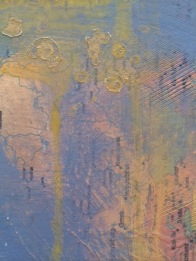Confession: Until I started teaching a Mixed Media workshop at the Arkansas Arts Center, I failed to see the value in collage. In my mind, collage reeked of the 1970’s decoupage trend combined with my memories of glue sticks in the 1st grade.

Laura Raborn, detail of Untitled (workshop experiment), 2015, mixed media on paper
I had a total change of heart during a recent workshop, when gluing images of women from a fashion magazine on a heavily textured painting. Like many of the methods I describe in this series of posts, collage works well in the layering process. Images can be altered to create or emphasize a concept that has no association with the original meaning of the collaged image. It is simply a tool to CONTRAST other marks in the piece or a tool to allude to an idea. In the example to the left, the female figure is barely visible, as it has been sanded, painted, and scrubbed. Once the eye finds the figure, it is as if a discovery has been made and the search for recognizable imagery among the abstraction and texture is part of the allure.
The tools you need are minimal: any type of glue (acrylic gel medium is my favorite) plus text, photos, magazine images, or whatever you can cut out and glue down. Remember, you can also appropriate from your own photos or artwork – just incorporate them into a larger piece. I’ve used my hand-drawn stencils as collage pieces and it is now one of my favorite techniques. In the painting below, can you see the strip of fabric that runs vertically on the right side? And the cut out male figure behind the girl’s eye? The collage item can be embedded into the painting and does not have to be highly visible or representational. It can help build the surface, establish a pattern, or support an idea presented elsewhere in the piece.

Laura Raborn, “Girl Looking Outward”, 2015, mixed media on wood panel, 16 x 20″
 As I’ve stated about many mixed media methods, collage is a method that CONTRASTS hand drawn or painted areas. This juxtaposition makes engaging composition. Take for example the work of Tyler Hildebrand, seen here on the left. The highly recognizable Waffle House signage contrasts the childlike drawings. Had the Waffle House sign been hand drawn or painted, the acute idea of American food signage would be diminished. The collage material makes the viewer go back and consider the sign again and again.
As I’ve stated about many mixed media methods, collage is a method that CONTRASTS hand drawn or painted areas. This juxtaposition makes engaging composition. Take for example the work of Tyler Hildebrand, seen here on the left. The highly recognizable Waffle House signage contrasts the childlike drawings. Had the Waffle House sign been hand drawn or painted, the acute idea of American food signage would be diminished. The collage material makes the viewer go back and consider the sign again and again.
 In another Hildebrand painting, the artist uses a drawing from his childhood and with painted line, tethers the drawing to the bulbous male form. Including the actual paper drawing in the composition conveys history. It doesn’t just allude to keepsakes – the dinosaur drawing on notebook paper IS a keepsake. The collage item encourages the viewer to ponder ideas about memory or childhood experiences traveling with us throughout adulthood.
In another Hildebrand painting, the artist uses a drawing from his childhood and with painted line, tethers the drawing to the bulbous male form. Including the actual paper drawing in the composition conveys history. It doesn’t just allude to keepsakes – the dinosaur drawing on notebook paper IS a keepsake. The collage item encourages the viewer to ponder ideas about memory or childhood experiences traveling with us throughout adulthood.
When considering various images to appropriate, remember the collage item(s) can become your surface under other media, as seen in the work of German artist, Sigmar Polke. Seen below, Polke draws scenes and uses stencils on top of fabric swatches. If you are a mixed media artist, it would be worth your time to further investigate the work of Sigmar Polke. As an experimental painter and photographer, he brilliantly used all of the techniques (plus some) we explore in the mixed media class at the Arkansas Arts Center – including image transfer, the use of language, collage, stencils, stamps, drawing, layers, patterns and textures. He was ferociously experimental with all materials, allowing for the accident to coincide with concept.
Lastly, another effective way to alter the meaning of the original collage item, is to merge photos in order to create something else altogether. Is there something you are passionate about but feel unable to convey through painting and drawing? Communicate your ideas through a creative fusing of photographic imagery. Let’s say my goal is to create a piece about sea turtles and human activity. After printing photos I found online, I am playing with various combinations (please note this is not a well thought out example – just a moderately successful demo):




Searching for photos online to fit the sea turtle idea, and trying to guess about scale while printing was fairly time consuming. Many collage artists keep organized files to store interesting images they come across in the mail, catalogs, magazines, and any other printed material. Then they just search their own categorized files when starting a project. Artist Holly Roberts does an excellent job explaining her process – and her work is inspirational for those trying to learn more about collage.
To see her work, visit http://www.hollyrobertsstudio.com/
For a short informative video about her methods, visit: https://www.youtube.com/watch?v=Z5dqxGVI4sA
Next up in the mixed media workshop series: Incorporating text and language into composit ions. Until then, thank you for reading….and a Happy Healthy New Year to all!
ions. Until then, thank you for reading….and a Happy Healthy New Year to all!


















